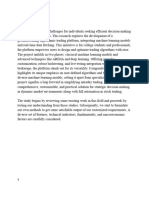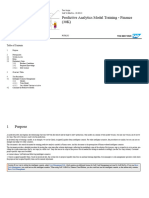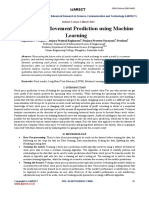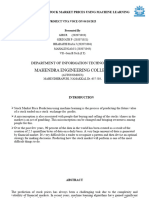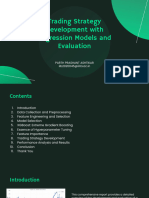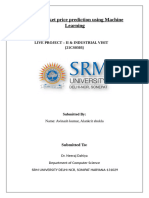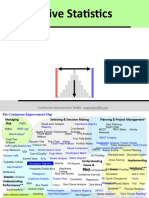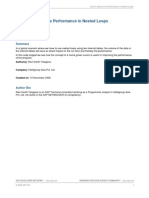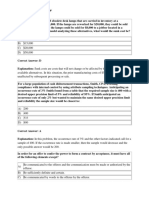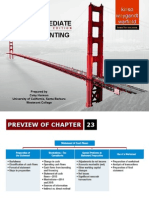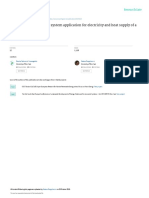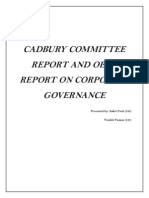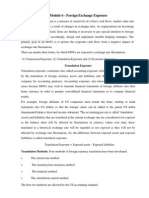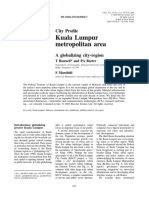SSRN 4383184
SSRN 4383184
Uploaded by
iyaddurraniCopyright:
Available Formats
SSRN 4383184
SSRN 4383184
Uploaded by
iyaddurraniOriginal Title
Copyright
Available Formats
Share this document
Did you find this document useful?
Is this content inappropriate?
Copyright:
Available Formats
SSRN 4383184
SSRN 4383184
Uploaded by
iyaddurraniCopyright:
Available Formats
Conditional Portfolio Optimization: Using machine learning to adapt
capital allocations to market regimes
By Ernest Chan*, Haoyu Fan, Sudarshan Sawal, and Quentin Viville.
Predictnow.ai, Inc.
First version: 2022-09-30
Second version: 2023-03-08
Third version: 2023-03-27
Current version: 2023-06-27
ABSTRACT
Conditional Portfolio Optimization is a portfolio optimization technique that adapts to market
regimes via machine learning. Traditional portfolio optimization methods take summary statistics
of historical constituent returns as input and produce a portfolio that was optimal in the past, but
may not be optimal going forward. Machine learning can condition the optimization on a large
number of market features and propose a portfolio that is optimal under the current market
regime. We call this Conditional Portfolio Optimization (CPO). Applications on portfolios in vastly
different markets suggest that CPO can outperform traditional optimization methods under
varying market regimes.
Keywords: Portfolio optimization, machine learning, factor models.
JEL Classification: G11, G17
AMS Classification: 49M37, 68T20, 90C30, 91G10, 91G60
*Founder and CEO, Predictnow.ai Inc. Email: ernest@predictnow.ai
Electronic copy available at: https://ssrn.com/abstract=4383184
Regime changes obliterate traditional optimization methods
In a previous paper, we discussed a machine-learning-based parameter optimization technique
we invented, called Conditional Parameter Optimization, or CPO (Chan, Belov, & Ciobanu,
Conditional Parameter Optimization: Adapting Parameters to Changing Market Regimes, 2021).
While CPO showed promise in optimizing the operating parameters of trading strategies, we
discovered that its greatest potential lies in its potential to optimize portfolio allocations. We refer
to this approach as Conditional Portfolio Optimization (which, fortuitously, shares the same
acronym).
To recap, traditional optimization methods involve finding the parameters that generate the best
results based on past data for a given business process, such as a trading strategy. For
instance, a stop loss of 1% may have yielded the best Sharpe ratio for a trading strategy tested
over the last 10 years, or stocking a retail shelf with sweets generate the best profit over the last
5 years. Although the numerical optimization process can be complex due to various factors
such as the number of parameters, the nonlinearity of objective functions, or the number of
constraints on the parameters, standard methods are available to handle such difficulties.
However, when the objective function is dependent on external time-varying and stochastic
conditions, traditional optimization methods may not produce optimal results. For example, in
the case of a trading strategy, the optimal stop loss may depend on the market regime, which
may not be clearly defined. In the case of retail shelf space optimization, the optimal selection
may depend whether it is a back-to-school season or a holiday season. Furthermore, even if the
exact set of conditions is specified, the outcome may not be deterministic. Machine learning is a
better alternative to solve this problem.
Machine learning can detect regime changes
Using machine learning, we can approximate this objective function using a neural network1, by
training its many nodes using historical data. The inputs to this neural network will not only
include the parameters that we originally set out to optimize, but also the vast set of features
that measure the external conditions. For example, to represent a “market regime”, we may
include market volatility, behaviors of different market sectors, macroeconomic conditions, and
many other input features. The output of this neural network would be the outcome you want to
optimize. For example, maximizing the future 1-month Sharpe ratio of a trading strategy is a
typical outcome. In this case you would feed historical training samples to the neural network
that include the trading parameters, the market features, plus the resulting forward 1-month
Sharpe ratio of the trading strategy as “labels” (i.e. target variables). Once trained, this neural
network can then predict the future 1-month Sharpe ratio based on any hypothetical set of
trading parameters and the current market features.
1
Recall that while a neural network is able to approximate almost any function (Hornik, Stinchcombe, &
White, 1989), there are other machine learning algorithms that can be used for this task as well. We
primarily use gradient-boosted regression trees, but for simplicity we will continue to call the machine
learner a “neural network”.
Electronic copy available at: https://ssrn.com/abstract=4383184
With this method, we “only need” to try different sets of hypothetical parameters to see which
gives the best Sharpe ratio and adopt that set as the optimal. We put “only need” in quotes
because, of course, if the number of parameters is large, it can take a very long time to try out
different sets of parameters to find the optimal. This is especially true when the application is
portfolio optimization, where the parameters represent the capital allocations to different
components of a portfolio. These components could be stocks in a mutual fund, or trading
strategies in a hedge fund. For example, in Table 1 we display the input features for one day of
a portfolio optimization problem:
Control features Market features
Table 1: A 1-day slice of features table as input to the neutral network
Assuming that the features that measure market regimes (denoted “Market features” in Table 1)
have a daily frequency, a 1-day slice of the features table nevertheless contains many rows
(samples). Each row represents a unique capital allocation – we call them “control features”. For
a portfolio that holds S&P 500 stocks, for instance, there will be up to 500 parameters (if cash is
included). In this case, we are supposed to feed into the neural network all possible
combinations of these 500 parameters, plus the market features, and find out what the resulting
forward 1-month Sharpe ratio (or whatever performance metric we want to maximize) is. All
possible combinations!"#$"%&"'&('&)&*+"+,&"-.(/+.0"%&/1,+".002-.+&3"+2"&.-,")+2-4".)"𝑤! "5"678"9:8"
Electronic copy available at: https://ssrn.com/abstract=4383184
.));</*1"%&".'&"*2+".002%/*1"),2'+"(2)/+/2*)8"+,&")&.'-,")(.-&",.)"[0, 1]"## combinations.
Even discretizing to a grid search, our computer will need to run till the end of time to finish. And
that is just for one day – training the neural net will require many days of such samples that
include the features and the resulting labels (forward 1-month Sharpe ratio). Overcoming this
curse of dimensionality by intelligently sampling the grid is one of the major breakthroughs our
team has accomplished. Intelligent sampling involves, for example, not sampling those parts of
the 500-dimensional grid that are unlikely to generate optimal portfolios, or not sampling those
parts of the grid that result in portfolios that are too similar to an existing sample.
Perhaps the following workflow diagrams can illuminate the process:
Labels: Historical
portfolio n-day Sharpe
Historical ratio
market features
Intelligent
Historical features sampling
Control features
(capital allocations) ML training
Trained ML model
Figure 1: Training a portfolio performance prediction machine
Electronic copy available at: https://ssrn.com/abstract=4383184
Current market
features
Trained ML model
Current features
Control features
(capital allocations)
Predicted n-day
Sharpe ratio
Figure 2: Live prediction of portfolio performance (inferences)
Constraints
Allocations Predicted
Sharpe
ratio
(0.2, 0.6, 0.2) 1.3
(0.25, 0.6, 0.15) 1.2 Intelligent
(0.3, 0.6, 0.1) 0.2 sampling
… …
(0.4, 0.5, 0.1) -0.1
(0.45, 0.5, 0.5) -2.0
Pick allocations
with highest
predicted Sharpe
ratio=1.3
Figure 3: Optimization step
Electronic copy available at: https://ssrn.com/abstract=4383184
Ranking is easier than predicting
Some readers may argue that if a neural network can predict the Sharpe ratio of a portfolio
based on its parameters and market features, why not use the network to directly predict the
underlying assets' returns and replace the original portfolio altogether? However, with our CPO
method, you don’t need to predict the portfolio’s Sharpe ratio accurately - you just need to
predict which set of parameters give the best Sharpe ratio. Even if the Sharpe ratio predictions
come with huge error bars, it is the ranking of predicted Sharpe ratio that matters. The situation
is analogous to many alpha models for stock selection: to form a profitable long-short portfolio of
stocks, an alpha model doesn’t need to predict the cross-sectional returns accurately, but only
needs to rank them correctly. We don’t have an alpha model to predict or even rank such cross-
sectional returns. (If we did, we wouldn’t be offering that to clients as a technology product – we
would offer it as a performance-fee-based managed account service.) Our client has used its
own alpha model to select the portfolio components for us already. All we need to do is to rank
the various capital allocations applied to a client’s portfolio based on their predicted Sharpe
ratios. It is a much less demanding predictive model if we only care that it gets the ranking of the
labels correctly (Poh, Lim, Zohren, & Roberts, 2020).
The Fama-French lineage
With CPO, not only is it unnecessary to predict cross-sectional returns, but we also don’t need
to use any cross-sectional features as input to our optimizer. Instead, we only use market
features that are sometimes called “time series factors” (Ruppert & Matteson, 2015). Can neural
networks really predict portfolio returns without any cross-sectional features? Let’s draw an
analogy with the Fama-French 3-factor model (Fama & French, 1995). Recall that Fama and
French proposed that we can explain (not predict) a portfolio’s returns using just 3 factors: the
market index return, SMB which measures the outperformance of small cap stocks over large
cap stocks, and HML which measures the outperformance of value stocks over growth stocks.
(Note that these factors can be negative, where “outperformance” becomes
“underperformance”.) The explanatory model is just a linear regression fit using these three
factors as independent variables against the current-period portfolio return, hopefully with a
decent R2. But if we use these as predictive factors (or features) to forecast the next-period
portfolio return, the R2 of such a regression fit will be poor. This may be because we have too
few factors. We can try to improve it by adding hundreds of factors (e.g. using our “factor zoo”
(Nautiyal & Chan, 2021)), capturing all manners of market regimes and risks. But many of these
factors will be collinear or insignificant and will continue to cause high bias and variance
(Murphy, 2012). So finally, we are led to the application of nonlinear machine learning model
that can deal with such multicollinearity and insignificance, via standard techniques such as
features selection ( (Man & Chan, The Best Way to Select Features? Comparing MDA, LIME,
and SHAP, 2021) and (Man & Chan, Cluster-based Feature Selection, 2021)). If we also add to
the input “control features” that condition the prediction on the capital allocation in the portfolio,
we have come full circle to Table 1 and arrive at Conditional Portfolio Optimization.
Comparison with conventional optimization methods
To assess the value Conditional Portfolio Optimization adds, we need to compare it with
alternative portfolio optimization methods. The default method is Equal Weights, which involves
allocating equal capital to all portfolio components. Another simple method is Risk Parity, where
the capital allocation to each component is inversely proportional to its return volatility. It is
Electronic copy available at: https://ssrn.com/abstract=4383184
called Risk Parity because each component is supposed to contribute an equal amount of risk,
as measured by volatility, to the overall portfolio’s risk. This method assumes zero correlations
among the components’ returns, which is of course unrealistic. Then there is the Markowitz
method, also known as Mean-Variance optimization. This well-known method, which earned
Harry Markowitz a Nobel prize, maximizes the Sharpe ratio of the portfolio based on the
historical means and covariances of the component returns through a quadratic optimizer. The
optimal portfolio that has the maximum historical Sharpe ratio is also called the tangency
portfolio. One of us wrote about this method in a previous blog post (Chan, 2014) and its
equivalence to the Kelly Formula. It certainly doesn’t take into account market regimes or any
market features. It is also a vagrant violation of the familiar refrain, “Past Performance is Not
Indicative of Future Results”, and is known to produce all manners of unfortunate instabilities
(see (Ang, 2014) and (López de Prado, 2020)). Nevertheless, it is the standard portfolio
optimization method that many asset managers use. Finally, there is the Minimum Variance
portfolio, which uses Markowitz’s method not to maximize the Sharpe ratio, but to minimize the
variance (and hence volatility) of the portfolio’s returns. Even though this approach does not
maximize a portfolio’s past Sharpe ratio, it often achieves better forward Sharpe ratios than the
tangency portfolio! Another case of “Past Performance is Not Indicative of Future Results”.
Some researchers compute expected cross-sectional returns using an alpha model and then
use Markowitz's optimization by inputting these returns (Tomasz & Katarzyna, 2021). However,
in practice most alpha models do not produce expected cross-sectional returns accurately
enough as input for a quadratic optimizer. As we explained before, the beauty of our method is
that we don’t need cross-sectional returns nor cross-sectional features of any kind as input to
the neural network or the optimizer. Only “time series” market features are used.
Let’s see how our Conditional Portfolio Optimization method stacks up against these
conventional methods.
(Note that transaction costs are not included in the following comparative studies. Our goal is to
demonstrate whether CPO improves the optimal solution compared to conventional methods,
and we do not expect CPO to transact more than, for e.g., the Markowitz method. In any case,
the difference is a second order effect. Also, when CPO is applied to an actively traded portfolio,
the transaction costs are primarily due to updating the portfolio components, not to capital
reallocation. In other words, the transaction cost in that case is due to alpha generation, not to
portfolio optimization due to CPO. In fact, if the actively traded portfolio is a portfolio of trading
strategies, transaction cost analysis by us is impossible since those strategies aren’t disclosed
to the CPO algorithm.)
We test how our CPO performs for an ETF (TSX: MESH) given the constraints that we cannot
short any stock8"and the weight 𝑤! of each stock s obeys 𝑤! ∈ [0.5%, 10%], but we can allocate
a maximum of 𝑤$ =10% of the portfolio to cash, with ∑! 𝑤! + 𝑤$ =1.
Electronic copy available at: https://ssrn.com/abstract=4383184
Period Method Sharpe Ratio CAGR
2021-08 to 2022-07 Equal Weights -0.76 -30.6%
(Out-of-sample)
Risk Parity -0.64 -22.2%
Markowitz -0.94 -30.8%
Minimum Variance -0.47 -14.5%
CPO -0.33 -13.7%
Table 2: MESH ETF
In the bull market, CPO performed similarly to the Markowitz method. However, it was
remarkable that CPO was able to switch to defensive positions and outperformed the Markowitz
method in the bear market of 2022. Overall, it improved the Sharpe ratio of the Markowitz
portfolio by more than 60%. That is the whole rationale of Conditional Portfolio Optimization - it
adapts to the expected future external conditions (market regimes), instead of blindly optimizing
on what happened in the past. Because of the long-only constraint and the tight constraint on
cash allocation, the CPO portfolio still suffered negative returns. But if we had allowed the
optimizer to allocate a maximum of 50% of the portfolio NAV to cash, it would have delivered
positive returns. The dramatic effect of cash allocation will be evident in the next example.
In this example, we tested the CPO methodology on a private investor’s tech portfolio,
consisting of 7 US and 2 Canadian stocks, mostly in the tech sector. We call this the Tech
Portfolio. The constraints are that we cannot short any stock, and the weight 𝑤! of each stock s
obeys 𝑤! ∈ [0%, 25%] and we can allocate a maximum of 𝑤$ =50% of the portfolio to cash, with
∑! 𝑤! + 𝑤$ =1.
Electronic copy available at: https://ssrn.com/abstract=4383184
Period Method Sharpe Ratio CAGR
2021-08 to 2022-07 Equal Weights 0.39 6.36%
(Out-of-sample)
Risk Parity 0.49 7.51%
Markowitz 0.40 6.37%
Minimum Variance 0.23 2.38%
CPO 0.70 11.0%
Table 3: Tech Portfolio
CPO performed better than both alternative methods under all market conditions. It improves
the Sharpe ratio over the Markowitz portfolio by 75% as the market experienced a regime shift
around January 2022. Here are the comparative equity curves:
Figure 4: Comparative performances of various portfolio optimization methods on Tech
Portfolio. (Out-of-sample period starts August 2021)
Even though this portfolio is tech-heavy, it was able to generate a positive return during this
trying period. The reason is that it can allocate 50% of the NAV to cash, as one can see by
looking at the time evolution of the cash component:
Electronic copy available at: https://ssrn.com/abstract=4383184
Figure 5: Cash allocation vs market regime of Tech Portfolio
In Figure 5, the highlighted time periods indicate when CPO allocated maximally to cash. The
overlay of the S&P 500 Index reveals that these periods are highly correlated with the
drawdown periods of the market index, even during out-of-sample testing that started in August
2021. This supports our hypothesis that CPO can rapidly adapt to market regime changes.
We also tested how CPO performs for some non-traditional assets - a portfolio of 8 crypto
currencies, again allowing for short positions and aiming to maximize its 7-day forward Sharpe
ratio,
Method Sharpe Ratio
Markowitz 0.26
CPO 1.00
Table 4: Crypto portfolio
(These results are over an out-of-sample period from January 2020 to June 2021, and the
universe of cryptocurrencies for the portfolio are BTCUSDT, ETHUSDT, XRPUSDT, ADAUSDT,
EOSUSDT, LTCUSDT, ETCUSDT, XLMUSDT). CPO improves the Sharpe ratio over the
Markowitz method by a factor of 3.8.
Finally, to illustrate that CPO doesn’t just work on portfolios of assets, we apply it to a portfolio
of FX trading strategies managed by a FX hedge fund WSG. (WSG is our client and we
published these results with their permission.) It is a portfolio of 7 trading strategies s, and the
allocation constraints are 𝑤! ∈ [0%, 40%], 𝑤$ ∈ [0%, 100%], with ∑! 𝑤! + 𝑤$ =1.
Electronic copy available at: https://ssrn.com/abstract=4383184
Method Sharpe Ratio
Equal Weights 1.44
Markowitz 2.22
CPO 2.65
Table 5: WSG’s FX strategies portfolio
(These results are over an out-of-sample period from January 2020 to July 2022). CPO
improves the Sharpe ratio over the Markowitz method by 19%. WSG has decided to deploy
CPO in production starting July 2022. Since then, CPO has added about 60bps per month to
the portfolio over their previous proprietary allocation method.
In all 4 cases, CPO outperformed both the naive Equal Weights portfolio and the Markowitz
portfolio during a market downturn, while generating similar performance during the bull market.
We do not claim that CPO can outperform all other allocation methods for all portfolios in all
periods. Some portfolios may be constructed to be so risk-neutral that CPO can’t improve on an
Equal Weights allocation. For other portfolios, CPO may underperform a conventional allocation
method for a certain period with the benefit of hindsight (ex-post), but nevertheless outperform
the best conventional allocation method selected at the beginning of the period (ex-ante). We
provide an illustration of this effect through a model portfolio below.
A model tactical asset allocation portfolio
The purpose of studying a model tactical asset allocation (TAA) portfolio is not only to
investigate whether CPO can outperform conventional allocation methods, but also to observe
how CPO allocates across different asset classes over evolving market regimes. The model
portfolio we selected comprises of five ETFs representing various asset classes: GLD (gold),
IJS (small cap stocks), SPY (large cap stocks), SHY (1-3 year Treasury bonds), and TLT (20+
year Treasury bonds). This portfolio is inspired by the Golden Butterfly portfolio created by
(Tyler, 2016). To train our machine learning model, we use the period January 2015 to
December 2018, while the out-of-sample test period covers January 2019 to December 2022.
The portfolio rebalances every 2 weeks, and CPO aims to maximize the Sharpe Ratio over the
forward 2-week period. The constraint is 𝑤! ∈ [0%, 100%], ∑! 𝑤! =1, with no cash allocation
allowed (since SHY is practically cash).
Electronic copy available at: https://ssrn.com/abstract=4383184
Period Method Sharpe Ratio CAGR
2015-01 to 2018-12 Equal Weights 0.51 3.60%
(In-sample)
Risk Parity 0.62 1.87%
Markowitz 0.59 5.26%
Minimum Variance 0.47 1.13%
CPO 0.63 3.93%
Period Method Sharpe Ratio CAGR
2019-01 to 2022-12 Equal Weights 0.62 6.61%
(Out-of-sample)
Risk Parity 0.22 1.16%
Markowitz -0.13 -2.09%
Minimum Variance -0.05 0.39%
CPO 0.42 3.83%
Table 6: In- and Out-of-sample performance of TAA portfolio
Table 6 shows during the out-of-sample period, CPO generates the second-highest Sharpe
ratio, trailing only the Equal Weights method. However, selecting Equal Weights ex-ante would
not have been an obvious choice, since it generated the second-lowest Sharpe ratio during the
in-sample period. If we were to choose a conventional allocation method ex-ante, Risk Parity
would have been our choice, but it underperformed CPO out-of-sample as measured by both
the Sharpe ratio and CAGR, the latter by more than threefold.
To gain more transparency into the CPO method, we can examine its allocations at various
times:
Electronic copy available at: https://ssrn.com/abstract=4383184
Figure 6: Time evolution of allocations of TAA portfolio (GLD is deep blue)
It is noteworthy that the portfolio had a high allocation to large-cap stocks beginning in July
2019, just before the market experienced a period of calm appreciation over the next six
months. The high allocation to short-term treasuries in January 2020 proved to be prescient in
light of the COVID-induced financial crisis that followed. The portfolio also had a high allocation
to gold at the beginning of 2022, which fortuitously anticipated the surge in commodity prices
due to the war in Ukraine. Finally, the allocation to small-cap stocks increased in mid-2022,
which performed better than large-cap stocks during that year.
For further interpretability, we list the most important 10 input features picked by our algorithm at
each rebalance date in Table 7. The features in this table are listed in decreasing importance
rank, as scored by the SHAP algorithm (Man & Chan, 2021). Though the top 10 features vary
Electronic copy available at: https://ssrn.com/abstract=4383184
over time, we can see that intraday volatility of SPX (SPX_HL_20_realVol_20), the return of
gold price (e.g. GLD_logMA5_250), the implied skewness of the SPX options (e.g.
SKEW_MA5), the implied volatility of volatility of the SPX (e.g. VVIX_MA20), and the treasury
bond yield (e.g. TR10_logMA5_20) are often picked.
Date Features Description
20 days Risk adjusted volatility of
2019/1/7 SPX_HL_20_realVol_20
SPX_logDayRange_20
Logarithimic Delta of GLD_Close 5 day Moving
GLD_logMA5_250
Average vs GLD_Close 250 Day Moving Average
SKEW_MA5 SKEW Moving Average of 5 days ( rolling mean)
Logarithimic Delta of GLD_Close 5 day Moving
GLD_logMA5_20
Average vs GLD_Close 20 Day Moving Average
SKEW_MA20 SKEW Moving Average of 20 days
GLD_realVolatility_20 20 day Volatility of GLD_logD1
VVIX_MA20 VVIX Moving Average of 20 days
Delta of TR10_realVolatility_20 vs
TR10_realVolatility_20_60
TR10_realVolatility_60
VVIX_MA5 VVIX Moving Average of 5 days ( rolling mean)
Canary_1 If BND has negative momentum
Logarithimic Delta of RUT_Close 5 day Moving
2019/7/8 RUT_logMA5_20
Average vs RUT_Close 20 Day Moving Average
Logarithimic Delta of TR10Y_Close 5 day Moving
TR10_logMA5_20
Average vs TR10Y_Close 20 Day Moving Average
Delta of HYG_realVolatility_20 vs
HYG_realVolatility_20_60
HYG_realVolatility_60
Delta of GLD_realVolatility_20 vs
GLD_realVolatility_20_60
GLD_realVolatility_60
20 days Risk adjusted volatility of
SPX_HL_20_realVol_20
SPX_logDayRange_20
Single Day Logarithmic returns - log delta of
GLD_logDayRet
GLD_Close vs GLD_Open
GLD_volumeRatio_20 Average Volume for 20 days
SKEW_MA5_20 Delta of SKEW vs SKEW_MA20
SKEW_MA20 SKEW Moving Average of 20 days
Delta of TR10Y_Close vs TR3M_Close (TR3M - 3
TR10_TR3M
Month Treasury Yield )
2020/1/6 SKEW_MA20 SKEW Moving Average of 20 days
Delta of TR10_realVolatility_20 vs
TR10_realVolatility_20_60
TR10_realVolatility_60
Delta of HYG_realVolatility_20 vs
HYG_realVolatility_20_60
HYG_realVolatility_60
Logarithimic Delta of SPX_Close 20 day Moving
SPX_logMA20_250
Average vs SPX_Close 250 Day Moving Average
GLD_volumeRatio_250 Average Volume for 250 days
Canary_1 If BND has negative momentum
Electronic copy available at: https://ssrn.com/abstract=4383184
Five logarithmic difference of HYG_Close and
HYG_logD5
HYG_Close (t-5)
SPY_volumeRatio_250 Average Volume for 250 days
SKEW_MA1_5 Delta of SKEW vs SKEW_MA5
TR10_RSI5 TR10Y_Close - 5 days Relative Strength Index
Delta of TR10_realVolatility_20 vs
2020/7/6 TR10_realVolatility_20_60
TR10_realVolatility_60
SKEW_MA20 SKEW Moving Average of 20 days
Backward_Risk_MV Risk factor of defensive strategy in the past cycle
RUT_logDayRange_5 5 Day Moving Average of RUT_logDayRange_1
Logarithimic Delta of GLD_Close vs GLD_Close
GLD_logMA1_250
250 day Moving Average
Risk factor of equal weights investment in the past
Backward_Risk_EW
cycle
Logarithimic Delta of GLD_Close 5 day Moving
GLD_logMA5_250
Average vs GLD_Close 250 Day Moving Average
Logarithimic Delta of HYG_Close 5 day Moving
HYG_logMA5_20
Average vs HYG_Close 20 Day Moving Average
20 days Risk adjusted volatility of
SPX_HL_20_realVol_20
SPX_logDayRange_20
Delta of HYG_realVolatility_20 vs
HYG_realVolatility_20_60
HYG_realVolatility_60
Two Day logarithmic difference of GLD_Close and
2021/1/4 GLD_logD2
GLD_Close (t-2)
TR10_realVolatility_20 20 day Volatility of TR10_logD1
Mean absolute deviation of net options pricing
NOPE_MAD_SPY
effect for SPY
Delta of HYG_realVolatility_20 vs
HYG_realVolatility_20_60
HYG_realVolatility_60
Delta of GLD_realVolatility_20 vs
GLD_realVolatility_20_60
GLD_realVolatility_60
Risk factor of equal weights investment in the past
Backward_Risk_EW
cycle
Five Day logarithmic difference of GLD_Close and
GLD_logD5
GLD_Close (t-5)
TR10_RSI20 TR10Y_Close - 20 days Relative Strength Index
20 days Risk adjusted volatility of
SPX_HL_20_realVol_20
SPX_logDayRange_20
Logarithimic Delta of TR10Y_Close 5 day Moving
TR10_logMA5_20
Average vs TR10Y_Close 20 Day Moving Average
Logarithimic Delta of RUT_Close 20 day Moving
2021/7/5 RUT_logMA20_250
Average vs RUT_Close 250 Day Moving Average
Delta of TR10_realVolatility_20 vs
TR10_realVolatility_20_60
TR10_realVolatility_60
Logarithimic Delta of GLD_Close 5 day Moving
GLD_logMA5_20
Average vs GLD_Close 20 Day Moving Average
RVX_MA20 RVX Moving Average of 20 days
VVIX_MA5_20 Delta of VVIX_MA5 vs VVIX_MA20
Electronic copy available at: https://ssrn.com/abstract=4383184
20 days Risk adjusted volatility of
SPX_HL_5_realVol_20
SPX_logDayRange_5
SPY_volumeRatio_20 Average Volume for 20 days
HYG_realVolatility_60 60 day Volatility of HYG_logD1
SKEW_MA5 SKEW Moving Average of 5 days ( rolling mean)
GLD_realVolatility_20 20 day Volatility of GLD_logD1
20 days Risk adjusted volatility of
2022/1/3 SPX_HL_20_realVol_20
SPX_logDayRange_20
Five Day logarithmic difference of GLD_Close and
GLD_logD5
GLD_Close (t-5)
SKEW_MA5 SKEW Moving Average of 5 days ( rolling mean)
TR10_realVolatility_60 60 day Volatility of TR10_logD1
VVIX_MA20 VVIX Moving Average of 20 days
VXN_MA5_20 Delta of VXN_MA5 vs VXN_MA20
Delta of TR10Y_Close vs TR1Y_Close (TR1Y - 1
TR10_TR1
Year Treasury Yield )
Logarithimic Delta of GLD_Close 5 day Moving
GLD_logMA5_20
Average vs GLD_Close 20 Day Moving Average
SKEW_MA1_5 Delta of SKEW vs SKEW_MA5
HYG_realVolatility_20 20 day Volatility of HYG_logD1
Single Day Logarithmic returns - log delta of
2022/7/4 GLD_logDayRet
GLD_Close vs GLD_Open
Delta of GLD_realVolatility_20 vs
GLD_realVolatility_20_60
GLD_realVolatility_60
Delta of TR10_realVolatility_20 vs
TR10_realVolatility_20_60
TR10_realVolatility_60
Backward_Risk_MV Risk factor of defensive strategy in the past cycle
Backward_Risk_MS Risk factor of aggresive strategy in the past cycle
Backward_Sharpe_MV Sharpe ratio of defensive strategy in the past cycle
Backward_Risk_IV Risk factor of risk parity strategy in the past cycle
250 day moving average ratio of HYG_Range
HYG_dayRangeRatio_250
(HYG_High - HYG_Low)
20 days Risk adjusted volatility of
SPX_HL_20_realVol_20
SPX_logDayRange_20
HYG_realVolatility_60 60 day Volatility of HYG_logD1
Table 7: Features with decreasing importance rank at each rebalance date
CPO software-as-a-service
For clients of our CPO software-as-a-service platform, we can optimize any objective function,
not just Sharpe ratio. For example, we have been asked to minimize Expected Shortfall, UPI,
etc. We can also add specific constraints to the desired optimal portfolio, such as average ESG
rating, maximum exposure to various sectors, or maximum turnover during portfolio rebalancing.
The only other input we require from them is the historical returns of the portfolio components
(unless these components are publicly traded assets, in which case clients only need to tell us
Electronic copy available at: https://ssrn.com/abstract=4383184
their tickers). If these components changed over time, we will also need the historical
components. We will provide pre-engineered market features (Nautiyal & Chan, 2021) that
capture market regime information. If the client has proprietary market features that may help
predict the returns of their portfolio, they can merge those with ours as well. Clients’ features
can remain anonymized. We will be providing an API for clients who wish to experiment with
various constraints and hyperparameters (such as the frequency of portfolio rebalancing) and
their effects on the optimal portfolio.
Just like ChatGPT, our CPO product will improve in optimality regularly due to our ever-
increasing number of pre-engineered features and the ever-enlarging search space. That is the
main advantage of machine-learning-based products – they will learn to improve themselves.
Conclusion
It is intuitively obvious that the optimal solution to a problem depends on the environment in
which it occurs, whether the problem is the optimal way to stock a retail shelf (back-to-school or
Christmas sales) or optimal asset allocation (risk-on or risk-off). Unfortunately, most
conventional optimization methods cannot consider the environmental context, as it often is
often ill-defined and may involve hundreds of variables. However, machine learning algorithms
excel in dealing with big data inputs that may contain redundant and insignificant variables. Our
CPO method leverages machine learning and big data to provide an optimal solution to many
commercial problems such as portfolio optimization that adapts to the environment. We have
demonstrated in multiple use cases that it can outperform conventional portfolio optimization
methods and have shown an example in tactical asset allocation where historical allocations
were timely.
Acknowledgements
We thank Pavan Dutt, Akshay Nautiyal, and Jai Sukumar for their assistance in features
engineering and software implementation of the CPO method, and to Sergei Belov and
Guillaume Goujard for their mathematical insights. We also thank Crispin Clarke, Erik
MacDonald, and Jessica Watson for their comments on the manuscript. Finally, we appreciate
the insightful questions raised by the audiences at UBS & Cornell Financial Engineering
Manhattan AI Speaker Series, NYU Mathematical Finance and Financial Data Science seminar,
CIBC's Finance-AI seminar, Fidelity AI Asset Management group, and many other public and
private forums where we presented CPO.
References
Ang, A. (2014). Asset Management: A Systematic Approach to Factor Investing. Oxford
University Press.
Chan, E. (2014, August 18). From http://epchan.blogspot.com/2014/08/kelly-vs-markowitz-
portfolio.html
Electronic copy available at: https://ssrn.com/abstract=4383184
Chan, E., Belov, S., & Ciobanu, R. (2021, April 1). From https://predictnow.ai/conditional-
parameter-optimization-adapting-parameters-to-changing-market-regimes/
Fama, E. F., & French, K. R. (1995). Size and book-to-market factors in earnigns and returns.
Journal of Finance, 50, 131-155.
Hornik, K., Stinchcombe, M., & White, H. (1989). Multilayer Feedforward Networks are Universal
Approximators. Neural Networks, 2, 359–366.
López de Prado, M. (2020). Machine Learning for Asset Managers. Cambridge University
Press.
Man, X., & Chan, E. (2021). The Best Way to Select Features? Comparing MDA, LIME, and
SHAP. The Journal of Financial Data Science, 3(1), 127-139.
Man, X., & Chan, E. P. (2021). Cluster-based Feature Selection. Market Technician, 90, 11-22.
Murphy, K. P. (2012). Machine Learning: A Probabilistic Perspective. The MIT Press.
Nautiyal, A., & Chan, E. (2021, September 9). From https://predictnow.ai/new-additions-to-the-
predictnow-ai-factor-zoo/
Poh, D., Lim, B., Zohren, S., & Roberts, S. (2020). Building Cross-Sectional Systematic
Strategies By Learning to Rank. https://arxiv.org/abs/2012.07149.
Ruppert, D., & Matteson, D. S. (2015). Statistics and Data Analysis for Financial Engineering
with R examples, Second Edition. Springer.
Tomasz, K., & Katarzyna, P. (2021). Building portfolios based on machine learning predictions.
Economic Research-Ekonomska Istraživanja.
Tyler. (2016). From https://portfoliocharts.com/portfolio/golden-butterfly/
Electronic copy available at: https://ssrn.com/abstract=4383184
You might also like
- Data Science Projects with Python.: A case study approach to gaining valuable insights from real data with machine learningFrom EverandData Science Projects with Python.: A case study approach to gaining valuable insights from real data with machine learningNo ratings yet
- Stock Market Analysis Using Supervised Machine LearningDocument17 pagesStock Market Analysis Using Supervised Machine LearningSai Teja deevela100% (2)
- F 3 PDF KNLCKZSCDocument26 pagesF 3 PDF KNLCKZSCrain0602199250% (2)
- Chemalite Sol Final 011112Document9 pagesChemalite Sol Final 011112pankyagr75% (4)
- Synopsis on Prediction of Share Market Index Movement Using Machine Learning AlgorithmsDocument7 pagesSynopsis on Prediction of Share Market Index Movement Using Machine Learning AlgorithmsVinod JagdaleNo ratings yet
- Minor Project 1 ReportDocument20 pagesMinor Project 1 ReportArijeet rosNo ratings yet
- Rohit Unit 1 ML NotesDocument27 pagesRohit Unit 1 ML NotesAbhishek SharmaNo ratings yet
- Stock Price Prediction Report - Parth Bathla - 18ECU016Document12 pagesStock Price Prediction Report - Parth Bathla - 18ECU016Parth BathlaNo ratings yet
- AutoML and XAI PDFDocument12 pagesAutoML and XAI PDFsusheendhar vijayNo ratings yet
- 30k S4hana2022 BPD en XXDocument10 pages30k S4hana2022 BPD en XXRoberto De FlumeriNo ratings yet
- Ads Phase5Document6 pagesAds Phase5RidhaNo ratings yet
- Stock Market Analysis Using Supervised Machine LearningDocument3 pagesStock Market Analysis Using Supervised Machine LearningKeerthi GuruNo ratings yet
- Stock Price Prediction - Machine Learning Project in PythonDocument14 pagesStock Price Prediction - Machine Learning Project in PythonVedant KohliNo ratings yet
- Paper 8660Document4 pagesPaper 8660IJARSCT JournalNo ratings yet
- AyushiGupta 1912940Document20 pagesAyushiGupta 1912940Banasthali StudentNo ratings yet
- Prediction of Stock Market Prices Using Machine Learning-1Document17 pagesPrediction of Stock Market Prices Using Machine Learning-1errorfinder22No ratings yet
- Machine Learning For Stock Market Prediction With Step by Step ImplementationDocument7 pagesMachine Learning For Stock Market Prediction With Step by Step ImplementationAditya SumanNo ratings yet
- Deep Learning VocabularyDocument6 pagesDeep Learning Vocabularyjaffar bikatNo ratings yet
- SAP COPA ConfigurationDocument0 pagesSAP COPA ConfigurationDeepak Gupta50% (2)
- SSRN Id4444871Document9 pagesSSRN Id4444871Vrinda VashishthNo ratings yet
- Stock Price Trend Forecasting Using Machine LearningDocument5 pagesStock Price Trend Forecasting Using Machine LearningInternational Journal of Innovative Science and Research TechnologyNo ratings yet
- Nandini Project ReportDocument55 pagesNandini Project Reportvijay kumar nNo ratings yet
- Python Will Make You Rich in The Stock MarketDocument8 pagesPython Will Make You Rich in The Stock Marketpradiprane85No ratings yet
- Trading Strategy Development With Regression Models and Evaluation - PPT - PARTHDocument12 pagesTrading Strategy Development With Regression Models and Evaluation - PPT - PARTHParth AshtikarNo ratings yet
- Python A.I. Stock PredictionDocument24 pagesPython A.I. Stock PredictionALGO INDUSTRY100% (1)
- Stock Price Trend Forecasting Using Supervised Learning MethodsDocument2 pagesStock Price Trend Forecasting Using Supervised Learning MethodsAliNo ratings yet
- ReportDocument7 pagesReportYASHNo ratings yet
- SAP Interview Questions and Answers - SAP BI Interview Questions PDFDocument2 pagesSAP Interview Questions and Answers - SAP BI Interview Questions PDFRohit AdhikariNo ratings yet
- 1 Live ProDocument6 pages1 Live Prokhushijain10sep1993No ratings yet
- Stock Price Movements Classification Using Machine and Deep Learning Techniques-The Case Study of Indian Stock MarketDocument8 pagesStock Price Movements Classification Using Machine and Deep Learning Techniques-The Case Study of Indian Stock MarketAlexandre RezendeNo ratings yet
- Stock Market Analysis PDFDocument5 pagesStock Market Analysis PDFVrinda VashishthNo ratings yet
- Descriptivestatistics 170330121728Document36 pagesDescriptivestatistics 170330121728Bethany Faith BatalunaNo ratings yet
- Apjis 30 1 31Document23 pagesApjis 30 1 31Ilmi TabassumNo ratings yet
- Ai DSSDocument27 pagesAi DSSMt SptNo ratings yet
- How To Improve The Performance in Nested LoopsDocument6 pagesHow To Improve The Performance in Nested LoopssushipiggieNo ratings yet
- In Certain Applications Involving Big Data, Data Sets Get So Large and Complex That It Becomes Difficult ToDocument16 pagesIn Certain Applications Involving Big Data, Data Sets Get So Large and Complex That It Becomes Difficult ToASHUMENDRA YADAVNo ratings yet
- NoCA2019-ProxyML 2019nov29Document24 pagesNoCA2019-ProxyML 2019nov29Salah UddinNo ratings yet
- Data Science For Financial Markets: Table of ContentsDocument146 pagesData Science For Financial Markets: Table of ContentsfadepNo ratings yet
- A Project Report: Submitted in Partial Fulfillment For The Award of The Degree ofDocument18 pagesA Project Report: Submitted in Partial Fulfillment For The Award of The Degree ofShikhar GuptaNo ratings yet
- Tarp Da 3Document7 pagesTarp Da 3Anurag KarkiNo ratings yet
- MicroStrategy Functions ReferenceDocument849 pagesMicroStrategy Functions ReferenceArielNo ratings yet
- Stock Market Prediction Using Machine LearningDocument5 pagesStock Market Prediction Using Machine LearningragadeepikaNo ratings yet
- AnClub Placements Prepbook 2024Document85 pagesAnClub Placements Prepbook 2024Sunmarg DasNo ratings yet
- ML FinalDocument34 pagesML Final4023 KeerthanaNo ratings yet
- Reading Sample Sap Press Profitability Analysis With Sap S4hanaDocument25 pagesReading Sample Sap Press Profitability Analysis With Sap S4hanaharishNo ratings yet
- Predicting Stock Values Using A Recurrent Neural NetworkDocument12 pagesPredicting Stock Values Using A Recurrent Neural NetworkMr SKammerNo ratings yet
- IJCRT2105404 Bigmart 4Document4 pagesIJCRT2105404 Bigmart 4727821tuad009No ratings yet
- Ch.03 Management Accounting S4HANA 2020 V1.5Document69 pagesCh.03 Management Accounting S4HANA 2020 V1.5MEKALA SAI VINDHYANo ratings yet
- FibonacciDocument3 pagesFibonacciHARSHVARDHAN KHATRINo ratings yet
- AssignmentDocument24 pagesAssignmentSanthi PalanisamyNo ratings yet
- credit card fraud detectionDocument8 pagescredit card fraud detectionstatus fellowsNo ratings yet
- Factset Presentation: Bonnie & MelodyDocument14 pagesFactset Presentation: Bonnie & MelodyBonnie AuNo ratings yet
- Can Machine Learning Be Used To Predict Market DirectionDocument11 pagesCan Machine Learning Be Used To Predict Market DirectionG NNo ratings yet
- STOCK MARKET Is One of The Oldest Methods Where A Normal Person Would Trade StocksDocument18 pagesSTOCK MARKET Is One of The Oldest Methods Where A Normal Person Would Trade StocksMamidi Chola SaikiranNo ratings yet
- Experimental Results For Case Study: The Financial Market Is A Complex, Evolutionary, and Non-Linear Dynamical SystemDocument4 pagesExperimental Results For Case Study: The Financial Market Is A Complex, Evolutionary, and Non-Linear Dynamical SystemSri NivasNo ratings yet
- COPA Config Manual SGGIDocument105 pagesCOPA Config Manual SGGIKumar NMNo ratings yet
- Advanced Analytics with Transact-SQL: Exploring Hidden Patterns and Rules in Your DataFrom EverandAdvanced Analytics with Transact-SQL: Exploring Hidden Patterns and Rules in Your DataNo ratings yet
- SAP PR Release Strategy Concept and Configuration Guide: A Case StudyFrom EverandSAP PR Release Strategy Concept and Configuration Guide: A Case StudyRating: 4 out of 5 stars4/5 (6)
- Business Forecasting: The Emerging Role of Artificial Intelligence and Machine LearningFrom EverandBusiness Forecasting: The Emerging Role of Artificial Intelligence and Machine LearningNo ratings yet
- Statistics with Rust: 50+ Statistical Techniques Put into ActionFrom EverandStatistics with Rust: 50+ Statistical Techniques Put into ActionNo ratings yet
- Implementing Machine Learning for Finance: A Systematic Approach to Predictive Risk and Performance Analysis for Investment PortfoliosFrom EverandImplementing Machine Learning for Finance: A Systematic Approach to Predictive Risk and Performance Analysis for Investment PortfoliosNo ratings yet
- Project - Investor Perception Towards Life Insurance Policies - Kotak Life Insurance 2020 FinalDocument87 pagesProject - Investor Perception Towards Life Insurance Policies - Kotak Life Insurance 2020 FinalAMRUTHA CITY CYBERNo ratings yet
- FPSC - Senior - Auditor - PDF - MCQs - Book - Free - Download - by Adspk PDFDocument27 pagesFPSC - Senior - Auditor - PDF - MCQs - Book - Free - Download - by Adspk PDFMeh JuttNo ratings yet
- Bookkeeping QuestionsDocument4 pagesBookkeeping Questionssusith luna100% (1)
- CPA REVIEW Questions - LAMBERSDocument51 pagesCPA REVIEW Questions - LAMBERSAlellie Khay JordanNo ratings yet
- Kieso 15ed Chapter 23 PresentationDocument79 pagesKieso 15ed Chapter 23 PresentationIdioms100% (2)
- SWOT AnalysisDocument3 pagesSWOT AnalysisGlydel ReyesNo ratings yet
- Advisorkhoj LIC Mutual Fund ArticleDocument6 pagesAdvisorkhoj LIC Mutual Fund ArticleHariprasad ManchiNo ratings yet
- KYC AsianPaintsDocument5 pagesKYC AsianPaintsneeltambe100% (8)
- MGT101 Finalterm Solved Paper1Document16 pagesMGT101 Finalterm Solved Paper1Erica Lindsey100% (1)
- Lec 1 Finance FunctionDocument39 pagesLec 1 Finance FunctionShabrina ShaNo ratings yet
- Tax Incentives and FDI in NigeriaDocument12 pagesTax Incentives and FDI in NigeriaSony AxleNo ratings yet
- Chap 5-MCQ Parity Without Key-1Document6 pagesChap 5-MCQ Parity Without Key-1magical_life96No ratings yet
- Money and Banking Solve Mcq'sDocument15 pagesMoney and Banking Solve Mcq'sSoham ChatterjeeNo ratings yet
- Objectives of Regional Rural Banks 1Document8 pagesObjectives of Regional Rural Banks 1Sandeep Sandy100% (1)
- BodyDocument43 pagesBodymd.jewel ranaNo ratings yet
- Hybrid Renewable Energy System Application For Electricity and Heat Supply of A Residential BuildingDocument14 pagesHybrid Renewable Energy System Application For Electricity and Heat Supply of A Residential BuildingJay WaltersNo ratings yet
- Section 8 Business FinanceDocument11 pagesSection 8 Business FinanceLeeana MaharajNo ratings yet
- Introduction To DJ MarketDocument8 pagesIntroduction To DJ MarketTieba issouf OuattaraNo ratings yet
- Brian Leip ThesisDocument63 pagesBrian Leip Thesisboytest2000No ratings yet
- PFIM - Unit 1 - IntroductionDocument9 pagesPFIM - Unit 1 - Introductionsahil63421952No ratings yet
- Cadbury Committee Report and Oecd Report On Corporate GovernanceDocument5 pagesCadbury Committee Report and Oecd Report On Corporate GovernanceVrushti Parmar100% (1)
- Cost and Finance Management SyllabusDocument6 pagesCost and Finance Management SyllabusDondu HarishNo ratings yet
- Ifm Module 6 TheoryDocument5 pagesIfm Module 6 TheoryAlissa BarnesNo ratings yet
- Ratio Analysis of L&T InfotechDocument36 pagesRatio Analysis of L&T Infotechrajwindernijjar1100% (1)
- MF GLOBAL HOLDINGS LTD., AS PLAN ADMINISTRATOR AND CORZINE ComplaintDocument149 pagesMF GLOBAL HOLDINGS LTD., AS PLAN ADMINISTRATOR AND CORZINE ComplaintACELitigationWatchNo ratings yet
- MCQS: Accounting: Correct Answer: ABC Costs Are More Accurate Than Absorption OnesDocument15 pagesMCQS: Accounting: Correct Answer: ABC Costs Are More Accurate Than Absorption OnesWilliam Arnold RañosaNo ratings yet
- City Profile Kuala-LumpurDocument14 pagesCity Profile Kuala-LumpurLiubov ZaichenkoNo ratings yet
- Sample Report - Project AppraisalDocument26 pagesSample Report - Project Appraisalram_babu_590% (1)





